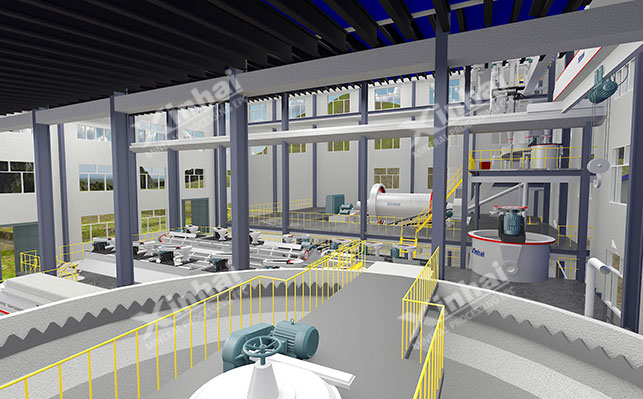
15311826613
Click to add WeChatThe main process of lithium extraction by alkaline method is limestone roasting. With the continuous innovation of technology, some new lithium extraction technologies have been developed according to the characteristics of ore and the disadvantages of the process. Let's learn about it together.

The mineral is roasted with limestone and then leached. The lithium concentration in the leaching solution is low (about 4g·L-1Li 2 O), and the volume of mother liquor produced is huge, which is about 10 to 15 times that of extracting lithium from spodumene by limestone roasting. The concentrated recovery of lithium requires a large amount of evaporation and high energy consumption. The main components of the leached slag are calcium silicate, calcium fluoride, etc. The amount of dry slag produced per ton of lithium hydroxide monohydrate is more than 40t, and the composition is complex and extremely difficult to use. Therefore, the pollution of solid slag is quite serious. The ore is rich in valuable elements such as K, Rb, and Cs. After leaching, they enter the leaching solution with lithium. After recycling, the economic benefits of the process can be increased.
For the comprehensive recovery of potassium, rubidium and cesium in the leachate, most studies introduce CO2 into the mother liquor of lithium extraction to recover potassium by crystallizing potassium bicarbonate, and then use chlorostannate or ferrocyanide to precipitate and separate rubidium and cesium in sequence. The process is long, inefficient, costly and environmentally stressful.
4-sec-butyl-2 (α-methylbenzyl) phenol (BAMBP) is used to extract and separate Cs and Rb at different OH- concentrations, and then hydrochloric acid is used to extract CsCl and RbCl. However, the extractant is expensive and toxic, and the separation coefficient of the extraction system is small. It takes multiple stages of extraction and back extraction to achieve the purpose of separation.
In order to reduce the cost of recovering K, Rb and Cs, there is currently a new separation method, which is to add sulfuric acid to the mother liquor after lithium carbonate precipitation, boil it, decompose CO2, and obtain K2SO4 product after cooling and filtering. Tartaric acid is then added to the filtrate, and potassium hydrogen tartrate product is obtained by filtering after reaction. The secondary filtrate is concentrated and evaporated to remove tartaric acid, and water and aluminum sulfate are added in turn to precipitate cesium alum and rubidium alum. The obtained alum salt reacts with barium hydroxide to obtain CsOH and RbOH products.
The total recovery rate of potassium in this process is >99%, the purity of cesium alum and rubidium alum is >99%, the material loss is small, the cost is low, the whole process is non-toxic and pollution-free, and a large amount of waste residue will not be generated.
The pressure cooking method of lithium mica lime milk is a new alkaline lithium extraction method, and its main process steps are:
1. Defluorination of lithium mica with high-temperature water vapor;
2. Pressure cooking of lime milk and defluorinated lithium mica at a liquid-solid ratio of 4:1 and a temperature of 159°C;
3. The pressure cooking liquid is evaporated to precipitate LiOH·H 2 O or the leachate is concentrated and CO 2 is introduced to precipitate lithium carbonate. Compared with the limestone roasting method, this process has a small material flow, a small amount of slag, a simple composition, and is easy to use. However, the large amount of HF gas produced during the pre-defluorination process is difficult to handle, and the solid particles in the slurry are refined and expanded at high temperatures, making them difficult to filter. The feeding and discharging process is difficult, affecting production efficiency.
Alkali fusion extraction is a lithium extraction method using sodium hydroxide as a solution. Its main process steps are:
1. Mix lepidolite with 50% NaOH solution at a mass volume ratio (g:ml) of 1:3.5 and react at 190°C;
2. Dilute the leachate and adsorb various alkali metal ions through a cation exchange resin;
3. Elute the resin with dilute sulfuric acid;
4. After the eluate is concentrated, sodium carbonate is added to precipitate lithium carbonate.
This process does not require pre-high-temperature defluorination, and there is no problem of hydrofluoric acid corrosion of equipment. The conversion process of potassium, rubidium, and cesium is completed at one time. The mother liquor after resin exchange is concentrated by crystallization to obtain high-value-added aluminum silicon products, which increases the economy of the process and reduces the output of polluted waste residues.
The above mainly introduces the process and steps of extracting lithium from lithium mica ore by alkaline method. In the actual ore dressing plant, any lithium ore dressing needs to be subjected to ore dressing test analysis. Only by analyzing, designing and customizing the appropriate lithium ore dressing process method can a higher lithium concentrate be obtained and an efficient return on investment be achieved.